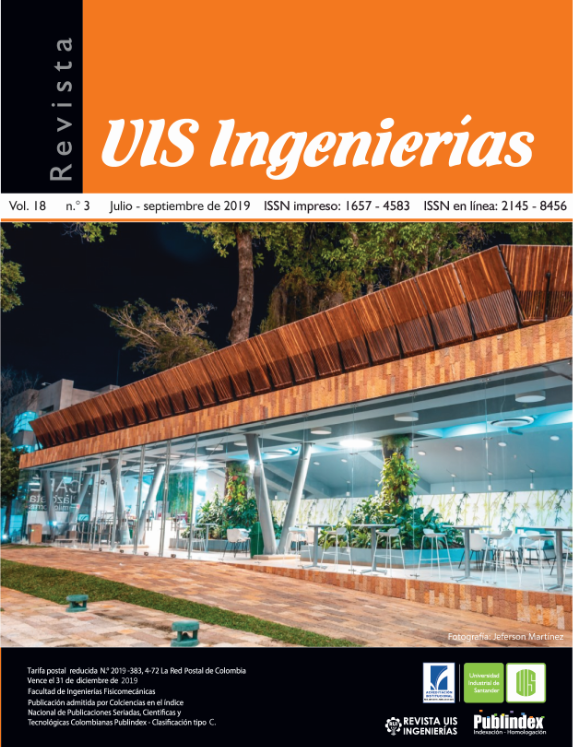Superficial metal matrix composite of AA5052-H32/Al2O3 manufactured by friction stir processing
Published 2019-03-22
Keywords
- metal matrix composite (MMC),
- friction stir processing (FSP),
- aluminum alloy,
- alumina,
- hardness
How to Cite
Abstract
In the present work, the Friction Stir Processing (FSP) procedure was used to manufacture a metal matrix composite (MMC) on the surface of an aluminum alloy AA5052-H32, using gamma-phase alumina particles as reinforcement. FSP is a technology based on FSW process with the purpose of modifying and enhancing material properties. It allows to obtain materials modified only superficially, improving tribological properties only in regions of interest, unlike MMC made by conventional methods. These processed parts can be subjected to further processing; as an example, surface processing allows characteristics such as the weldability of the base material to be maintained, unlike some MMC obtained by casting.
For the manufacture of MMC two tools were used. Tool 1 was used to introduce the particles in the base metal and Tool 2 was used to distribute the particles in the processed region. MMC beads were fabricated at 1000 rpm, 100 mm/min, and two insertion passes. Three groups of samples were obtained: processed without particles, with micro particles (5µm) and with nano particles (50nm). For each group the number of distribution passes varied. Base material hardness value was 68 HV. The results show that, the processed material without particles presented a decrease in hardness of 13 %. Processed material with micro and nano particles, with two distribution passes, showed increased hardness values between 6 and 20% respectively. Increasing the distribution passes up to four, caused a hardness reduction to values close to the base material. The results indicate that it is possible to modify favorably the surface properties of a material using FSP.
Downloads
References
[2] M. Sarkari Khorrami, S. Samadi, Z. Janghorban, and M. Movahedi, “In-situ aluminum matrix composite produced by friction stir processing using FE particles,” Mater. Sci. Eng. A, vol. 641, pp. 380-390, Aug. 2015. doi: 10.1016/J.MSEA.2015.06.071
[3] V. Sharma, U. Prakash, and B. V. M. Kumar, “Surface composites by friction stir processing: A review,” J. Mater. Process. Technol., vol. 224, pp. 117-134, 2015. doi: 10.1016/J.JMATPROTEC.2015.04.019
[4] E. Martínez, O. A. González-Estrada, and A. Martínez, “Evaluación de las propiedades tribológicas de materiales compuestos de matriz metálica (MMCs) procesados por técnicas de fabricación aditiva con haz láser (SLM),” Rev. UIS Ing., vol. 16, no. 1, pp. 101–114, 2107. doi: 10.18273/revuin.v16n1-2017010
[5] M. W. Mahoney and S. P. Lynch, “Friction-Stir Processing,” Thousand Oaks, Ca, 2006.
[6] R. S. Mishra and Z. Y. Ma, “Friction stir welding and processing,” Mater. Sci. Eng. R Reports, vol. 50, no. 1-2, pp. 1–78, 2005. doi: 10.1016/J.MSER.2005.07.001
[7] Material Property Data “ Matweb - Aluminum 5052-H32.”, [Online]. Available: http://www.matweb.com/search/DataSheet.aspx?MatGUID=96d768abc51e4157a1b8f95856c49028&ckck=1. [Accessed: 26-Apr-2017].
[8] X. Cao, Q. Shi, D. Liu, Z. Feng, Q. Liu, and G. Chen, “Fabrication of in situ carbon fiber/aluminum composites via friction stir processing: Evaluation of microstructural, mechanical and tribological behaviors,” Compos. Part B Eng., vol. 139, pp. 97–105, 2018. doi: 10.1016/j.compositesb.2017.12.001
[9] R. Moshwan, F. Yusof, M. A. Hassan, and S. M. Rahmat, “Effect of tool rotational speed on force generation, microstructure and mechanical properties of friction stir welded Al–Mg–Cr–Mn (AA 5052-O) alloy,” Mater. Des., vol. 66, pp. 118–128, 2015. doi: 10.1016/J.MATDES.2014.10.043

